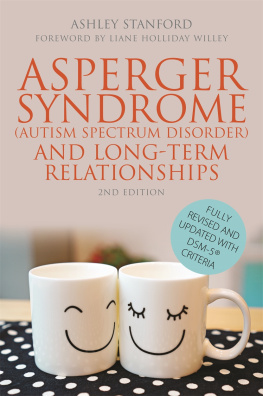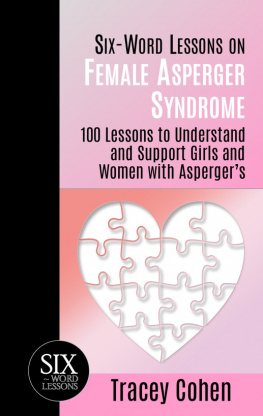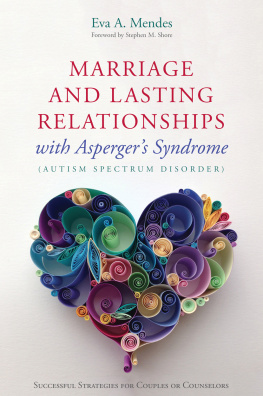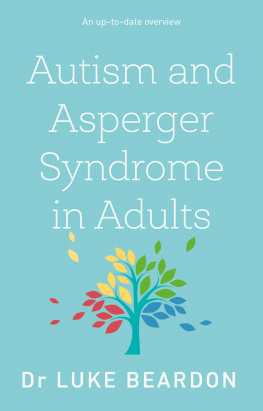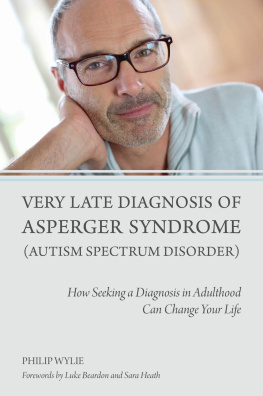Meltdowns andOverstimulation: Surviving and Thriving with AspergerSyndrome
Published By: Elaine Dayat Smashwords
Copyright 2014 ElaineDay
Introduction
Hello, and welcome to Meltdowns and MoodSwings: Surviving and Thriving with Asperger Syndrome. In thechapters that follow, I will be taking a look at dealing with someof the most common "quirks" associated with AS. As a fellow Aspie,I deal with many of these symptoms on a daily basis and I know howdisruptive they can be, as well as how suddenly they can come on. Iwill be talking about the coping strategies I use, as well asstrategies employed by others. It is my hope that I can help otherson the spectrum better deal with their symptoms regardless of age,gender, or other qualities.
Asperger Syndrome is a very complexneurological disorder, and very little is understood about itsorigin. Nevertheless, symptoms such as hypersensitivity, meltdowns,and emotional intensity are hallmarks of this condition. Thesesymptoms affect everyone with AS to some degree, whether they arechildren or adults, male or female.
For me, a diagnosis of AS wasn't made until Iwas 32 years of age. This is not uncommon, as Asperger Syndrome wasrarely heard of when my generation was younger. Thankfully, abetter understanding of the condition and better diagnosticcriteria mean that more and more people on the spectrum are finallygetting the diagnoses they need and deserve. If you or someone youlove has AS, it is my hope that this book will help provide somemuch-needed coping tools and strategies.
Please note that this book is merely part onein a series. Over time, I will look at things like finding theright therapist, learning to cope in social situations, and muchmore. It is my desire to provide other Aspies with the things thatI lacked for so long, such as tools and resources, and I hope thatmy books provide great value to you and your loved ones.
Meltdowns
Before we delve into coping with meltdowns,it is important to look at what they are. To a passerby, it maylook a lot like a temper tantrum, but in truth it is the inabilityto cope with a change in expectations or circumstances. Forexample, I often melt down in the grocery store when they are outof something I need or when there are simply too many people and mysenses get overloaded. I melt down when yelled at or confronted,when I get confused about what someone is saying, and in many othercircumstances. While meltdowns take different shapes for everyone,mine often consist of crying, yelling, or even banging my headagainst a wall or other object. Once a meltdown has ended, I oftenfeel both exhausted and embarrassed. This is not an uncommonreaction, and some Aspies need 24 hours or more to fully recoverfrom the emotional and sensory overload of a meltdown.
Coping with meltdowns has never comenaturally to me. For 32 years, I was undiagnosed, so I had no ideathat I was having meltdowns. My feelings during these episodes havealways felt real and justified, and they have just seemed likenormal reactions even though most other people do not have them. Ittook a diagnosis, a lot of research, and a great deal of therapy tounderstand what a meltdown was and that there was much I could doto prevent and even control them.
Learn Your Triggers
One of the biggest parts of preventing orcontrolling meltdowns is learning what triggers them for you. Forme, there are many potential triggers, including those I listedabove. Common meltdown triggers include change, the need to takepart in social events, sensory overstimulation, and unpredictablesituations. As you can see, the triggers themselves can often beunchangeable. What can change, however, is our ability to noticethem and do something about them.
Taking an inventory of your triggers is agreat place to start, and you may find it easier to do if you get aloved one to help. If you are married, have a roommate, or have aparent who has witnessed your meltdowns, ask them what types ofthings typically happen before you lose control. If you havesomeone who can observe your behavior, ask them to write down thesetting, emotions, and circumstances that they notice before ameltdown and look to see what each meltdown has in common. Once youknow your triggers, you will be in a better place to do somethingto change your reactions.
Create a Sensory Space
This tip really applies to many aspects ofAsperger Syndrome and has changed my life. In my home, I have anoffice/sensory room where I can go when I feel overwhelmed andwhere my family knows when I need to be left alone. In my room Ihave my computer, but I also have a futon where I can sleep if I amoverwhelmed, a weighted blanket to help me calm down, a compressionvest for desensitizing myself, and numerous stress balls and thingsI can safely squeeze or throw to get out aggression without havinga full-blown meltdown. My family is good at recognizing the earlysigns of a meltdown and my wife often lets me know when it might bea good idea to come into my sensory space and use my blanket, spendsome time playing a mindless game, or even turn off the lights anduse my eye mask and earplugs to desensitize.
I understand that not everyone has an extraroom in their home that can be converted to a sensory space, butthere is still hope. You can make a sensory space almost anywhere,whether it is a basement, the front porch, or even a portion ofyour bedroom. Simply designate a space and fill it with the toolsthat YOU need to help de-stress and desensitize and let your lovedones or roommates know that this space is off limits. I have a signthat I hang on my door when I am using my room for sensory time,and my family understands that when the sign is up, I amoverwhelmed and need time to myself.
Another great idea for your sensory space isto include hobbies. For example, I enjoy video games andrefinishing furniture, so my sensory space has my video game systemand my toolbox, as well as enough space to sand a dresser or painta desk to help me unwind and de-stress. Whatever your hobbies maybe, creating a space to engage in them alone within your sensoryspace can help you get the most benefit from it.
Weighted Items
While the jury is still out on just howweighted blankets and other weighted items work, the simple fact isthat they do. Many believe that by creating an abundance ofsensation, they help to decrease overstimulation. Deep pressurefrom a weighted blanket is one of the most calming things in theworld for me. These blankets can be quite costly, but if you or aloved one are handy with a sewing machine, there are many patternsonline that will allow you to make one at home with only fabric andsome poly-fill beads. My blanket weighs 20 lbs., but the weightshould be adjusted to how much pressure you need as well as yourbody size. There are sizing guides online that can help you ensurethat you create a blanket, lap pad, or shoulder pad that will provetherapeutic for you. One recommendation is to pick a fabric thatfeels good to you. My blanket is made out of a cooler material, asthe weight can cause you to get hot very quickly, but others preferthe touch of fleece or other soft fabrics. There is no wrong way tomake a weighted blanket as long as it is something that feelstherapeutic to you.
Therapy
Therapy, especially Cognitive BehaviorTherapy, or CBT, can be especially helpful in dealing withmeltdowns and mood swings. CBT works by changing the way we thinkabout a particular subject, situation or stimuli, thus changing theway we react to it. It took me 33 years to discover CBT, but tookonly a couple of sessions before I started to notice real changesin my behavior and emotional patterns. It is highly recommended tofind a practitioner who works with people on the spectrum, as theywill understand that your brain works differently than most andwill be able to teach you CBT specifically for AS symptoms. Youwill also find that there are books you can order online or throughbookstores that provide CBT for people with Aspergers that they cando at home. The book I use,
Next page





